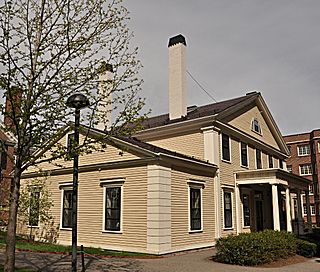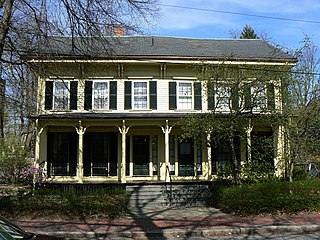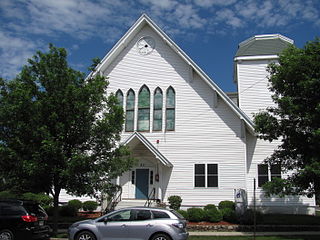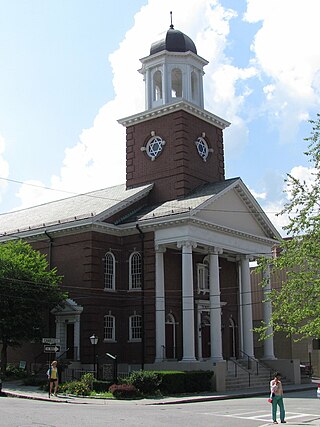
Hamilton Hall is a National Historic Landmark at 9 Chestnut Street in Salem, Massachusetts. Designed by noted Salem builder Samuel McIntire and built in 1805–1807, it is an excellent instance of a public Federal style building. It was built as a social space for the leading families of Salem, and was named for Founding Father and Federalist Party leader Alexander Hamilton. It continues to function as a social hall today: it is used for events, private functions, weddings and is also home to a series of lectures that originated in 1944 by the Ladies Committee.

The Beck-Warren House, also known as the Warren House, is a historic house located in Cambridge, Massachusetts. Now on the campus of Harvard University, this large Greek Revival wood-frame house was built in 1833 for Professor Charles Beck, and was later purchased and adapted by the physically disabled Henry Clarke Warren, a Sanskrit scholar. Since 1899 it has belonged to Harvard University, for whom it presently houses offices. The house was listed on the National Register of Historic Places in 1996.

The Bigelow Street Historic District encompasses a uniform collection of 19th century houses on most of the length of Bigelow Street in Cambridge, Massachusetts, just northwest of Central Square. Bigelow Street was laid out in 1868, and the street was almost completely built out by 1874, resulting in a fairly uniform streetscape of Second Empire architecture. The district was added to the National Register of Historic Places in 1982.

The E. H. Brabrook House is an historic duplex house in Cambridge, Massachusetts. It is a two-story wood-frame structure, six bays wide, with a side gable roof and a porch extending across its front facade. It was built in 1849 by Ezra Brabrook, a local furniture dealer. It is one of the first Italianate houses in Old Cambridge, retaining distinctive Greek Revival characteristics such as its corner pilasters and front door sidelight windows, while including an Italianate wide cornice and brackets.

102–104 Inman Street is a historic house located in Cambridge, Massachusetts. It is locally significant as one of a series of well-preserved Greek Revival duplexes on Inman Street.

The Building at 104–106 Hancock Street is an historic cottage in Cambridge, Massachusetts. Built in 1839, it is a significant local example of transitional Greek Revival/Gothic Revival architecture, and one of the earliest houses built after the subdivision of Dana Hill. It was listed on the National Register of Historic Places in 1983.

The Building at 106–108 Inman Street in Cambridge, Massachusetts is one of a series of well-preserved Greek Revival duplexes on Inman Street. This house was built in 1845, and features very straightforward Greek Revival styling, most notably in the pilasters that run the full two story height of the building, separating each of the front facade's bays. The building has a later Italianate porch sheltering the centered entrances.

The Samuel J. Wright House, also known as the Greek Revival Cottage, is an historic house at 59 Rice Street in Cambridge, Massachusetts. This modest 1.5-story Greek Revival cottage is one of the finest of its type in northwestern Cambridge. It was built in 1847 by housewright Samuel J. Wright. It features a fully pedimented gable end, original pedimented gable dormers on the left side, and fluted columns supporting an entablature. The side-hall front door is flanked by full-length sidelight windows and pilasters.

The Maple Avenue Historic District is a residential historic district on Maple Avenue between Marie Avenue and Broadway in Cambridge, Massachusetts, United States. It encompasses a street with a cohesive collection of well-preserved, predominantly Italianate and Second Empire, houses, in which the original spacing and setting has been preserved. It includes houses on both sides of Maple Avenue, numbered from 8 to 33, among which stand several Queen Anne and Colonial Revival houses. The district was added to the National Register of Historic Places in 1983.

The Asa and Sylvester Abbot House is a historic two-family house at 15–17 Porter Road in Andover, Massachusetts. Built in the 1830s, it is a rare local example of the duplex in a rural setting. It was listed on the National Register of Historic Places in 1982, where it is incorrectly listed at 15–17 Andover Street.

206 West Street is historic house located in Reading, Massachusetts. It is locally significant as a well-preserved example of a Greek Revival cottage.

The First Congregational Church is an historic church in Stoneham, Massachusetts, United States. Built in 1840, it is a fine local example of Greek Revival architecture, and is a landmark in the town center. It was listed on the National Register of Historic Places on April 13, 1984. The church is affiliated with the United Church of Christ; the current pastor is the Rev. Ken McGarry.

The First Unitarian Church is a historic former church building in Stoneham, Massachusetts. One of Stoneham's more stylish Gothic Revival buildings, the Stick style wood structure was built in 1869 for a Unitarian congregation that was organized in 1858. The building was listed on the National Register of Historic Places in 1984, and included in the Central Square Historic District in 1990. It presently houses the local Community Access Television organization.

The Warren Sweetser House is a historic house at 90 Franklin Street in Stoneham, Massachusetts. It is one of the finest Greek Revival houses in Stoneham, recognized as much for its elaborate interior detailing as it is for its exterior features. Originally located at 434 Main Street, it was moved to its present location in 2003 after being threatened with demolition. The house was found to be eligible for listing on the National Register of Historic Places in 1984, but was not listed due to owner objection. In 1990 it was listed as a contributing resource to the Central Square Historic District at its old location. It was listed on its own at its new location in 2005.

The Micah Williams House is a historic house at 342 William Street in Stoneham, Massachusetts. The 1+1⁄2-story Greek Revival cottage was built c. 1830 by Micah Williams. Unlike many Greek Revival buildings, which have the gable end facing the street, this one has the front on the roof side, a more traditional colonial orientation. Its facade is five bays wide, with a center entrance sheltered by a hip-roof portico with square columns. The house was built by Williams for his daughter.

The Daniel French School is a historic school building at 38–40 Common Street in Waltham, Massachusetts. Built in 1847 by a prominent local educator, it is a well-preserved example of vernacular Greek Revival architecture, and is important for the role it played in Waltham's 19th century educational environment. The building was listed on the National Register of Historic Places in 1989. It is now a residential duplex.

The Wakefield Trust Company is a historic commercial building at 371 Main Street in Wakefield, Massachusetts. Built in 1924, it is one of three buildings on the west side of Main Street that give the town center a strong Classical Revival flavor. The building was listed on the National Register of Historic Places in 1989.

The West Ward School is a historic school at 39 Prospect Street in Wakefield, Massachusetts. Built in 1847, it is the only surviving Greek Revival schoolhouse in the town. The building was listed on the National Register of Historic Places in 1989. It is now maintained by the local historical society as a museum property.

The Second Unitarian Church is a historic church and synagogue building at 11 Charles Street in Brookline, Massachusetts. Built in 1916 for a Unitarian congregation, it was acquired by the innovative Reform Jewish Temple Sinai congregation in 1944. It is a high quality example of Colonial Revival/Georgian Revival architecture, and was listed on the National Register of Historic Places in 1985.

The Farrington House is a historic house at 30 South Main Street in Concord, New Hampshire. Built in 1844 as a duplex, it is a distinctive local example of high-style Greek Revival architecture. It was listed on the National Register of Historic Places in 1982.























